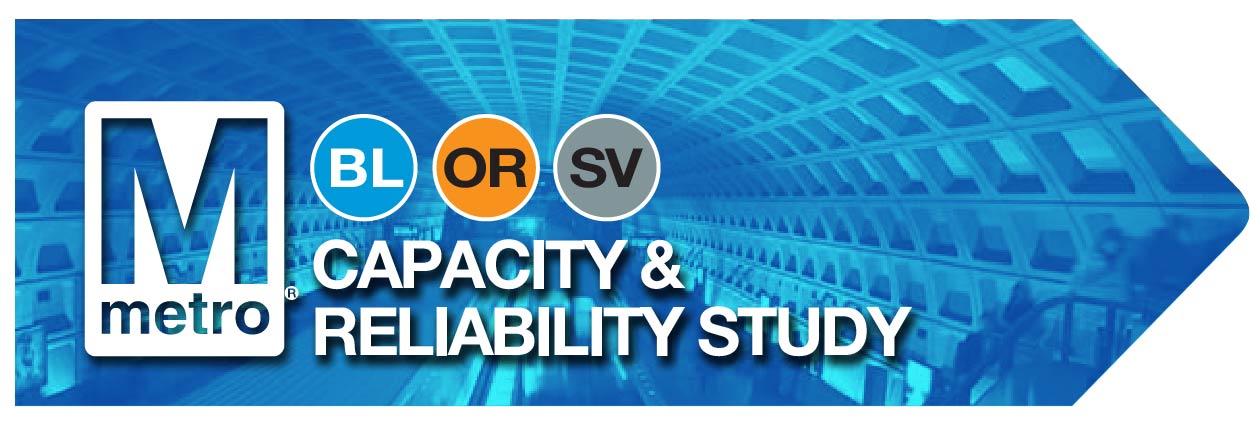
Learn about the six alternatives
Maps and summary profiles are available for each of the six alternatives.
Understanding how each alternative would meet the four goals
Metro undertook a performance assessment and cost-benefit analysis (CBA) that measures how well each alternative would meet the four goals, and how they compare against each other in terms of costs and benefits. The CBA assigned each alternative a score and rank in two categories: relative Benefits and Cost-Effectiveness, based on performance on 14 performance measures directly linked to the four BOS transit goals. For more detail on the CBA/performance assessment, see this section below and the BOS Alternatives Evaluation Report.
The remainder of this page includes descriptions and conceptual maps of each alternative, their key benefits and limitations, and results from the CBA/performance assessment. This information is also summarized in a set of alternative profiles and in a short video about each alternative.
Explore the alternatives:
CLICK HERE to view profiles of all alternatives in PDF format
The No-Build Alternative investigates whether the four study goals can be met by the existing transportation system plus improvements and projects the region has already committed to fund and deliver by 2045, including:
- Metro's Capital Improvement Program Projects, such as:
- Rail system state of good repair
- Track and structures repair and rehabilitation
- Station modernizations
- New railcars and buses
- Projects in the region's financially-constrained long-range transportation plan, Visualize 2045, such as:
- The Purple Line
- DC Circulator and Streetcar expansion
- Bus Rapid Transit (BRT) projects in Montgomery County and Northern Virginia
The No-Build Alternative assumes the transportation network would be as it is planned and funded today, with no additional investments. It is used as a baseline to compare the benefits and costs of the other BOS alternatives.
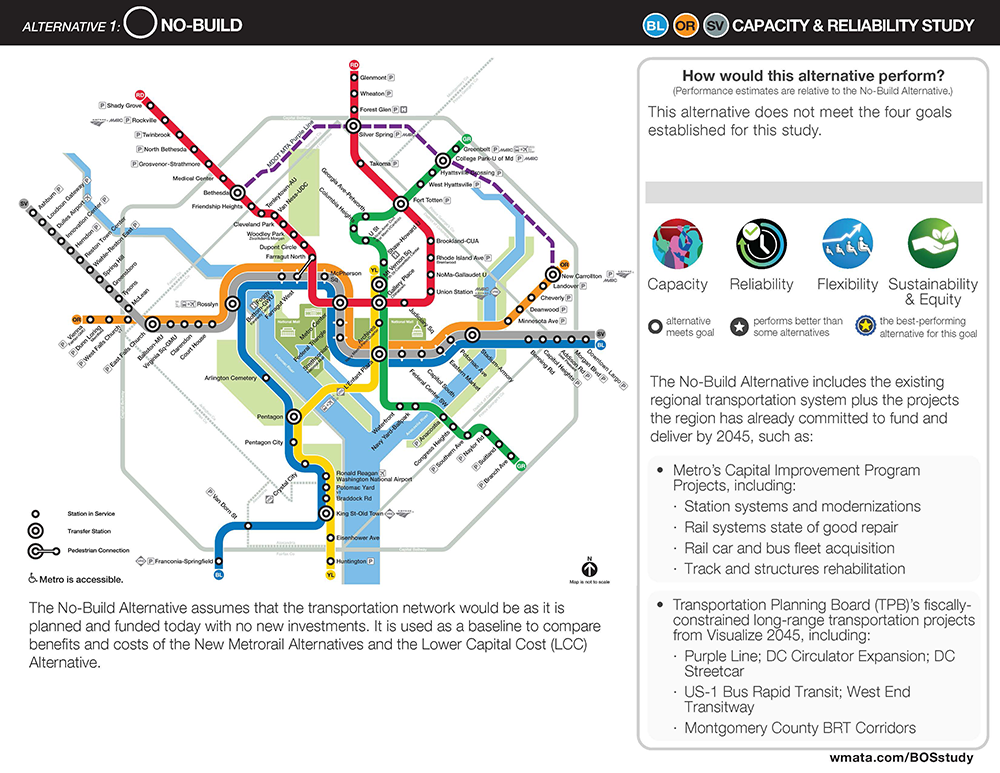
Key benefits and limitations
The No-Build Alternative would not meet the four BOS study goals. It will substantially improve Metro's reliability and on-time performance and make Metro transit even more environmentally friendly, but would not meet all four goals. The other five alternatives were developed as options to meet those goals: capacity, reliability, flexibility, and sustainability/equity.
CLICK HERE to view profiles of all alternatives in PDF format
The Rail Optimization and Bus Service Alternative (also known as the Lower Capital Cost Alternative) includes a variety of changes that may meet the identified needs without building a new Metrorail line, some of which are already underway:
- Updating rail infrastructure for enhanced flexibility to match service to ridership demand, including the ability to store and turn around trains at more locations
- New bus rapid transit (BRT) and commuter bus service (approximately 60 routes)
- Expanding core Metro stations to reduce crowding
- Adjusting railcar seating to increase capacity
- Introduction of dynamic rail scheduling to improve reliability
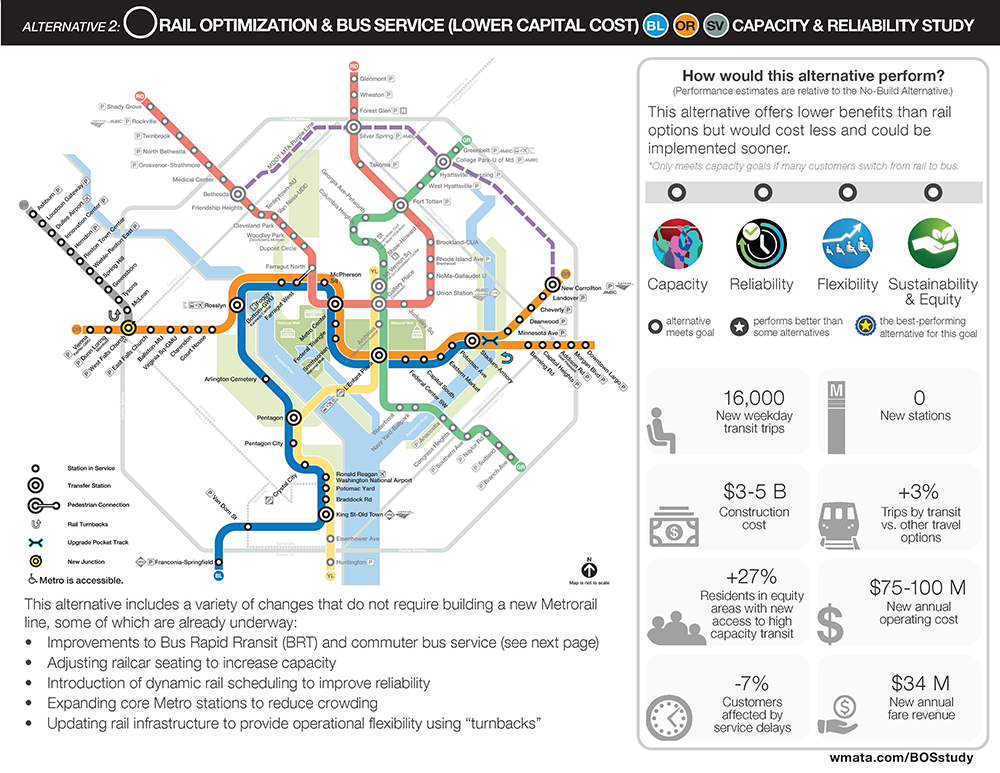
The Rail Optimization and Bus Service Alternative offers substantially fewer and lower benefits than the rail options, but would cost much less and could be implemented sooner. This alternative is intended to reduce peak-hour crowding on the Blue, Orange, and Silver lines by encouraging some customers to shift to competitive, prioritized bus alternatives, including:
Bus Rapid Transit (BRT)
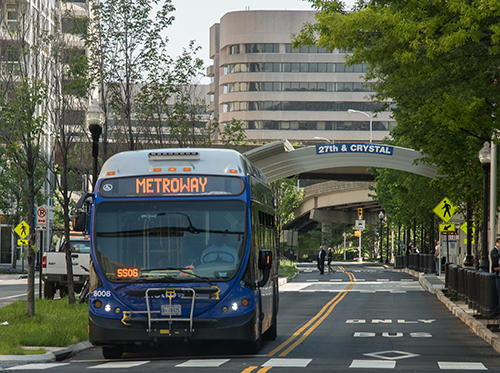
- 3 proposed BRT routes in Virginia
- 3 proposed BRT routes in Maryland
- Bus priority (bus lanes, queue jumps, traffic signals)
- Off-board fare payment and all-door boarding
- Dedicated stations with amenities
Commuter Bus Service
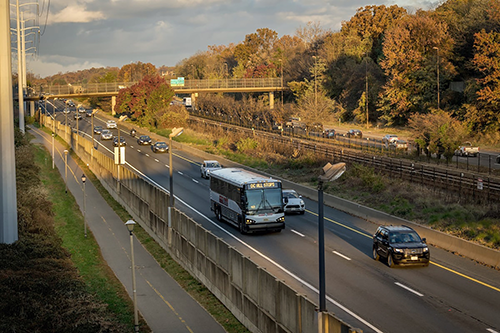
- 54 routes on highways and major roads between Virginia, Maryland, and downtown District of Columbia
- Higher-speed service with limited stops
- Weekday peak hours only
- 40-foot coaches with comfortable seats and wi-fi
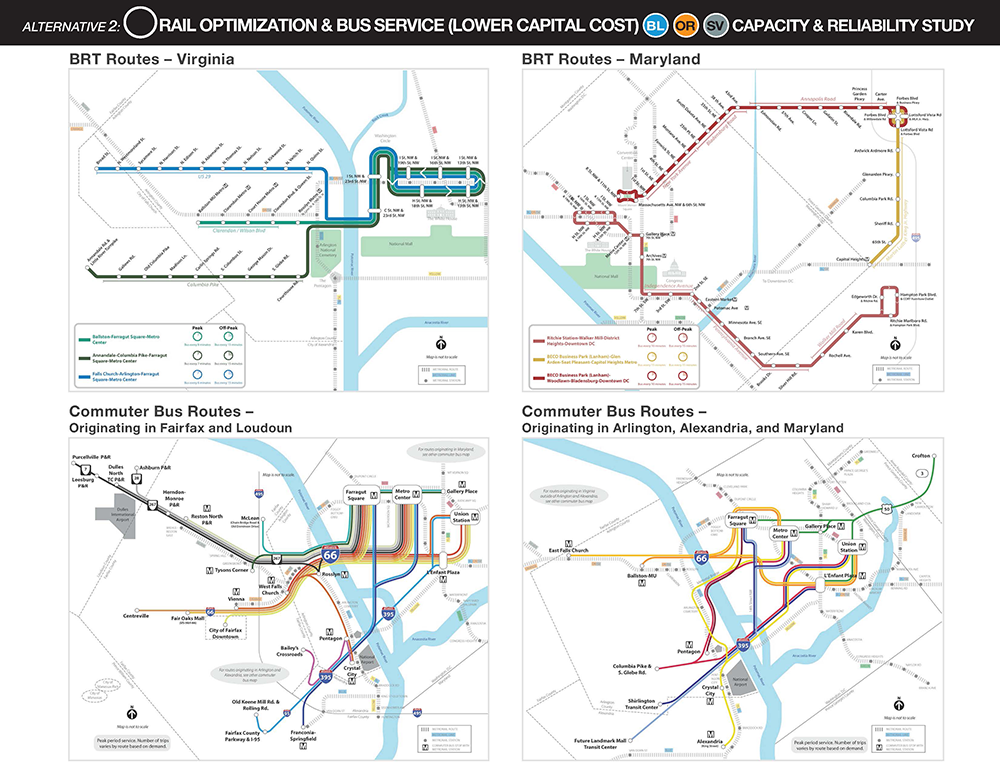
CLICK HERE to view profiles of all alternatives in PDF format
The Blue Line would serve a new second Rosslyn Station (with a direct tunnel connection to the existing Rosslyn Station), cross the Potomac River, then run under M Street through Downtown DC to Union Station. From there it would run northeast through Ivy City, Port Towns, Hyattsville, and College Park to Greenbelt. It would operate on separate tracks from the existing Green and Yellow lines.
This alternative would do well with on-time performance and reducing the potential for trip delays. It also has the lowest construction cost of the rail alternatives. It would serve the following areas:
- Rosslyn
- Georgetown
- Downtown DC
- Union Station
- Union Market
- Ivy City
- Fort Lincoln
- Port Towns
- Hyattsville
- College Park
- Greenbelt
Transfers would be available at the following stations:
- Greenbelt
- College Park-U of Md
- Mt Vernon Sq
- Rosslyn II
- Farragut Station
- Union Station
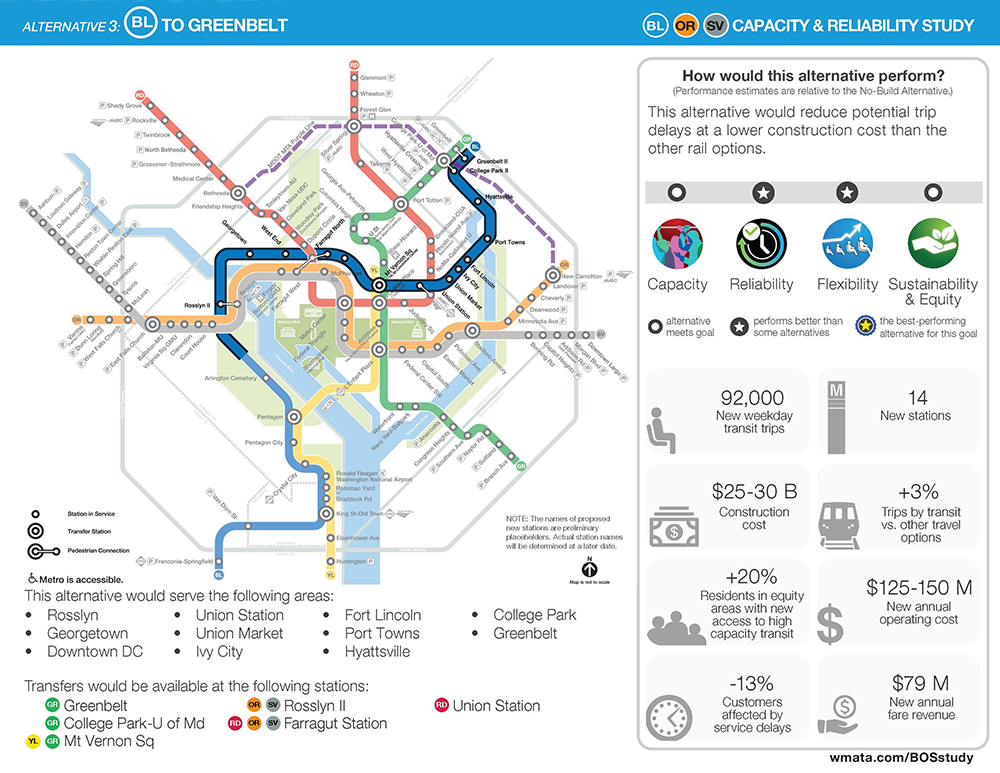
CLICK HERE to view profiles of all alternatives in PDF format
This realignment of the Blue Line would also serve a second Rosslyn Station (with a direct tunnel connection to the existing Rosslyn Station), and would run under M Street between Georgetown and Union Station. From Union Station it would turn south, providing new north-south service in Waterfront and Navy Yard and creating new rail access in fast-growing areas such as Buzzard Point, St. Elizabeths, and National Harbor, before crossing over the Woodrow Wilson Bridge to Alexandria.
This alternative would perform best at reducing crowding, growing ridership, increasing system connectivity, and providing access to transit and jobs in equity areas. It would serve the following areas:
- Rosslyn
- Georgetown
- Downtown DC
- Navy Yard
- Buzzard Point
- St. Elizabeths
- Forest Heights
- Oxon Hill
- National Harbor
- Alexandria
Transfers would be available at the following stations:
- Navy Yard-Ballpark
- Mt Vernon Sq
- Capitol South
- Rosslyn II
- Farragut Station
- Union Station
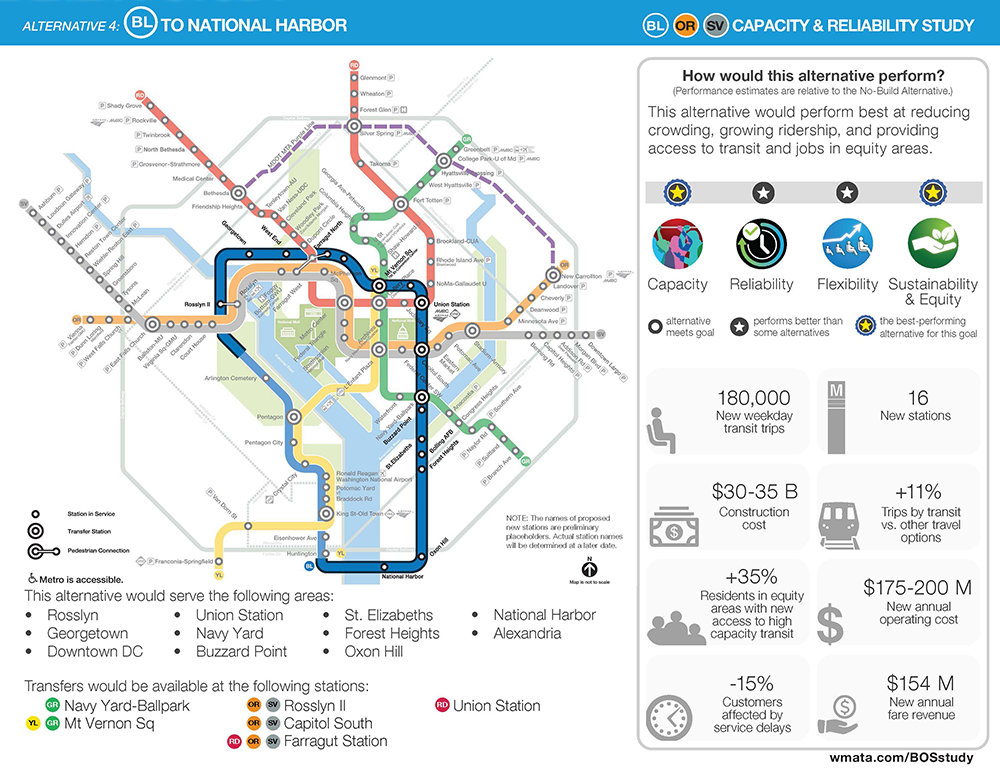
CLICK HERE to view profiles of all alternatives in PDF format
This alternative would build a separate tunnel for the Silver Line in Northern Virginia, between the West Falls Church Station and a second Rosslyn Station. This new tunnel would separate the Silver Line from the Orange and Blue lines, and would support express service or a mix of express and local service. From the new Rosslyn Station the Silver Line would follow the same route as the Blue Line alternative to Greenbelt, from Georgetown to Union Station then through Ivy City, Port Towns, Hyattsville, and College Park to Greenbelt.
This alternative would maximize train throughput, increase operational flexibility, and provide customers with multiple route options. It would support a mix of local and express service in the following areas:
- West Falls Church
- Ballston
- Rosslyn
- Georgetown
- Downtown DC
- Union Station
- Capitol Hill
- Ivy City
- Port Towns
- Hyattsville
- College Park
- Greenbelt
Transfers would be available at the following stations:
- Greenbelt
- College Park-U of Md
- Mt Vernon Sq
- West Falls Church
- Rosslyn
- Farragut Station
- Union Station
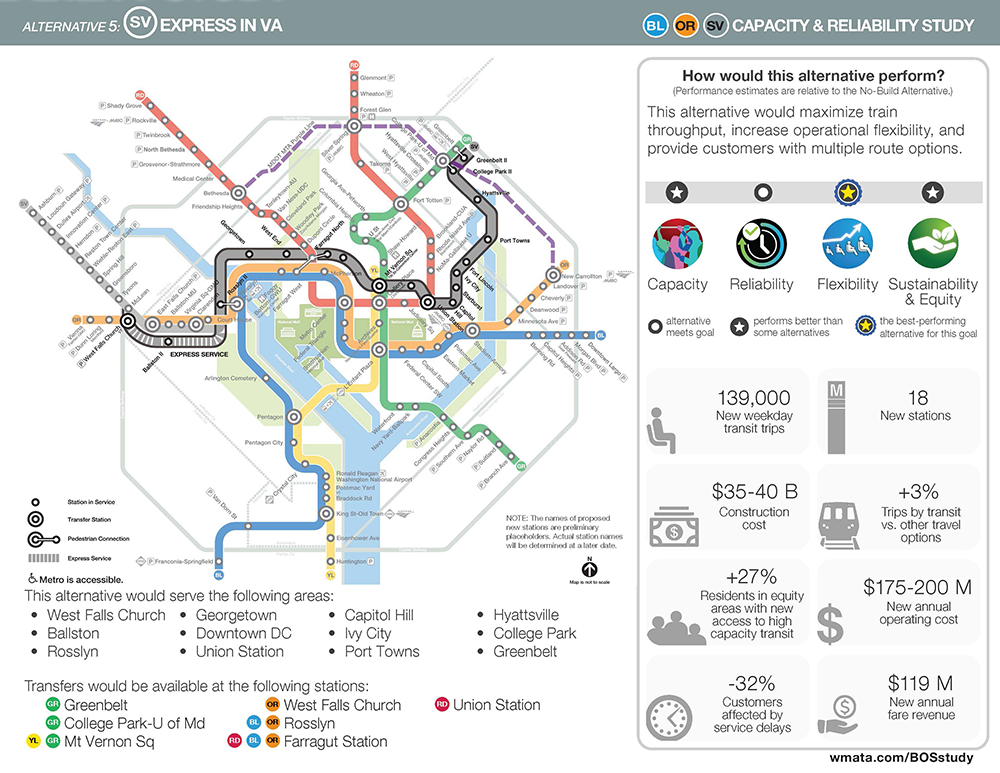
CLICK HERE to view profiles of all alternatives in PDF format
This alternative separates the Silver Line from the Orange Line at Clarendon, providing a new connection at a second Rosslyn Station before continuing in a separate tunnel through Georgetown and Downtown DC to Union Station. From Union Station it would serve Ivy City and the Port Towns area, then continue east along the Annapolis Rd/450 corridor to New Carrollton.
This alternative would perform best at reducing travel times between Downtown DC and areas near the eastern Orange Line. It would serve the following areas:
- Rosslyn
- Georgetown
- Downtown DC
- Union Station
- Union Market
- Ivy City
- Fort Lincoln
- Port Towns
- Landover Hills
- New Carrollton
Transfers would be available at the following stations:
- Mt Vernon Sq
- New Carrollton
- Rosslyn
- Farragut Station
- Union Station
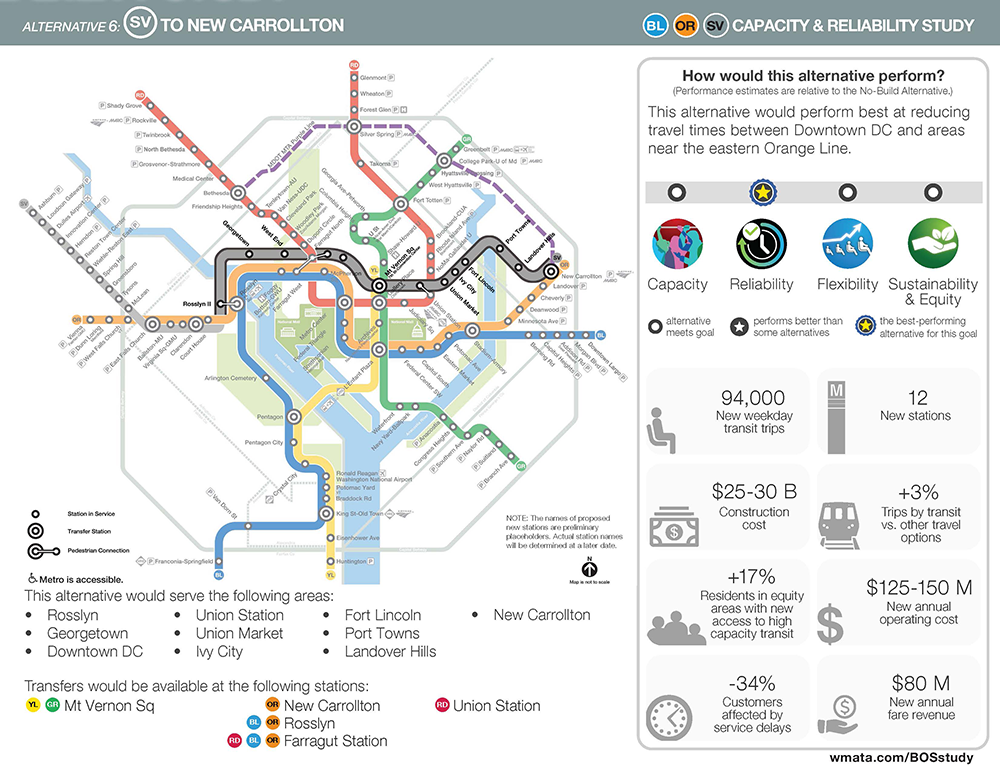
Comparing the alternatives using a Cost-Benefit Analysis (CBA)
The two tables below show how the alternatives compare in terms of meeting the four goals, their relative scores in the cost-benefit analysis, and other important metrics such as projected new transit trips, new annual fare revenue, estimated construction costs, and estimated annual costs for operations and maintenance. See the BOS Alternatives Evaluation Report for full detail on the CBA and performance assessment.
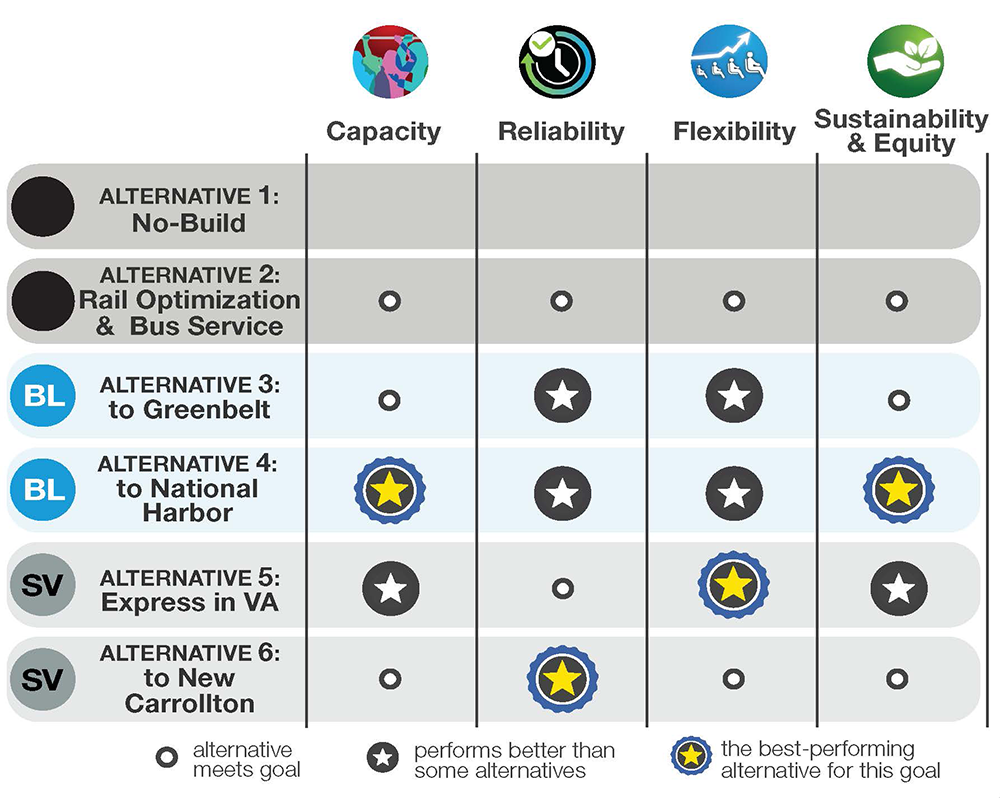
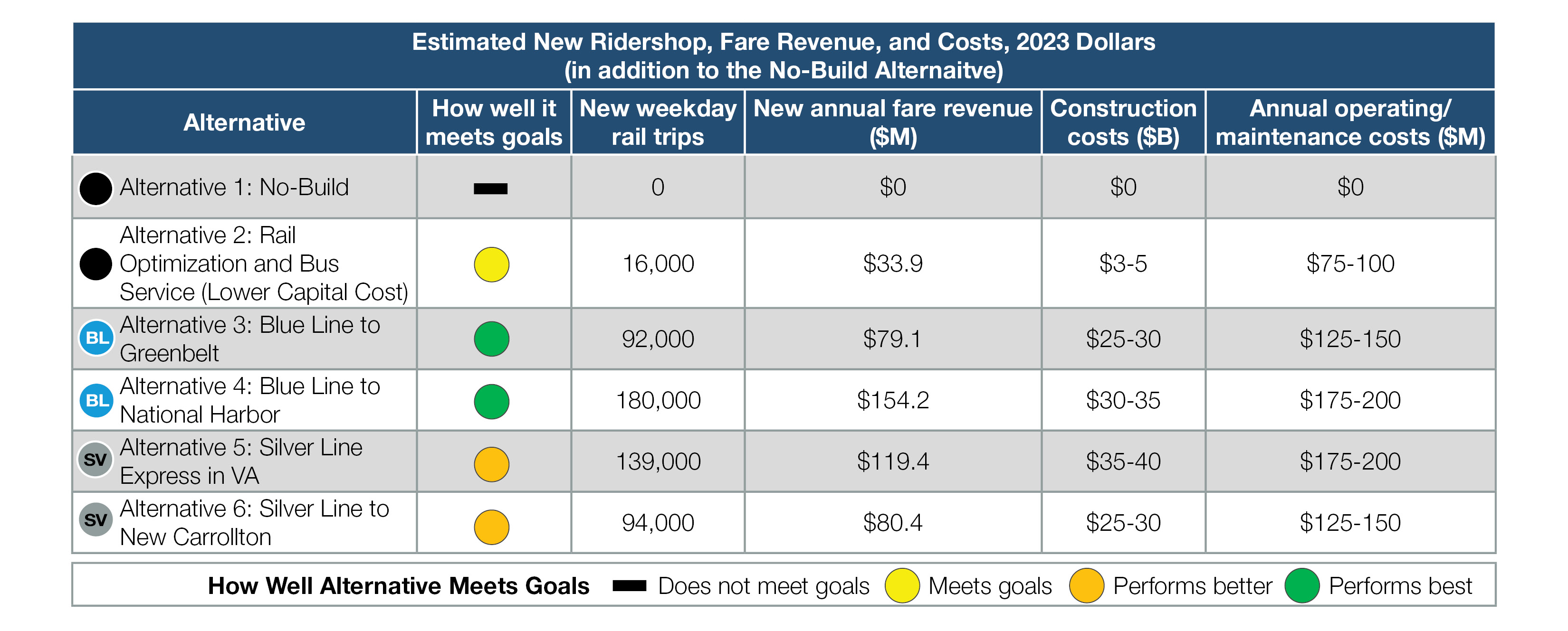
Based on the cost-benefit analysis, the Blue Line to National Harbor alternative would provide the highest level of benefits and would be the second most cost-effective of the five build alternatives considered. This alternative would extend Metrorail service into new markets and areas targeted for growth and development, such as Waterfront, Buzzard Point, St. Elizabeths, and National Harbor. It would also provide two new transfer stations at Capitol South and Navy Yard, which would reduce crowding at existing transfer stations, increase system resiliency, and improve customers' ability to travel both north-south and east-west. It would also expand new access to high-capacity transit and economic opportunities to the greatest number of Equity Emphasis Areas.
The Rail Optimization and Bus Service Alternative would provide relatively few benefits above the No-Build future, but it would be the most cost-effective option. This is largely due to a much lower estimated construction cost than the rail build alternatives (approximately $3-$5 billion vs. $25-$35 billion). However, it must be noted that this alternative's ability to meet the four study goals depends entirely upon heavy investments in bus prioritization strategies by cities and counties, as well as the willingness of thousands of peak-hour commuters to switch from rail to competitive bus alternatives.
Resource Kit
Alternative development and evaluation materials
- BOS Study Brochure - This quick reference guide to the BOS Study contains an overview of the study goals, the final six proposed alternatives and how each alternative performed in the cost-benefit analysis.
- Large-Format Alternative Maps - These maps are larger, high-resolution versions of the maps for each alternative.
- BOS Study Purpose and Need Report - This report summarizes the key issues identified in the BOS corridor, the project's purpose and need, and the project's goals and objectives.
- BOS Alternatives Development Report - This report describes the alternatives development process, including identification of a full 'universe' of potential options and the screening process used to narrow those options to the final six alternatives under consideration.
- BOS Alternatives Evaluation Report - This report assesses the relative benefits and cost-effectiveness of each alternative compared to the baseline future outcomes represented by the No-Build alternative.
- Public Engagement Report, Rounds 1 & 2 - This report communicates the community engagement strategies and tools used during the first two rounds of public engagement, as well as analysis and records of results.
Development of Alternatives
The four goals and an initial set of project ideas was presented to the public for feedback at open houses and through an online survey. More than 2,000 responses were collected, resulting in a total of 275 potential concepts.
Initial Alternatives and Screening
Based on the identified needs and goals, and informed by community partners and public feedback, those 275 project concepts were refined into 16 initial alternatives. Those 16 alternatives were then screened against a No-Build Alternative in the following order to consider whether and how each would:
- Serve BOS travel patterns and relieve projected passenger crowding
- Help attain the four identified goals
- Serve areas with projected population and employment densities suitable for Metrorail service
- Align with stakeholder and public feedback and comments
Only alternatives that passed each of the four screening questions were recommended for more detailed study and evaluation.
For more detailed information on the initial screening process, please click here.